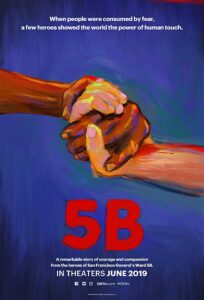This oral history of the early days of the first AIDS ward unit in the US shines a continuing bright light on the ignorance, fear, and homophobia that persists even today.


As tolerance for homosexuality grew in the 1970s, gay and lesbian Americans came out of the shadows. But just as society began to begrudgingly accept this widespread lifestyle that had been hidden for centuries, a new and tragic illness ravaged the community. And it was a death sentence. We now know that the hysteria that fed on hate of homosexuality was unjustified, and today, while living with HIV is common, we can never forget this dark moment in our nation’s history.
“5B” focuses on the AIDS ward at San Francisco General Hospital from 1983 through its closure in 2003. Following the science proved to be critical in stamping out the untruths that spread like wildfire. Co-directors Dan Krauss and Paul Haggis let the doctors, nurses, caregivers, family members, and survivors tell their story. And even if you think you’ve seen it all already, hearing from the people who lived through it is vital.

Certain stories resonate. Activist Rita Rockett tells us about her work to keep spirits high in a ward filled with so much death. We see video of her in the 1980s bouncing around the halls delivering specific food requests. Journalist Hank Plante, one of the first openly gay television reporters, recounts his experiences in covering the epidemic. He remembers the time that then President Ronald Reagan first referenced AIDS publicly. And several nurses emotionally discuss the uncertain procedures constructed on the fly (often with little scientific basis) to guard against contracting the disease. One nurse in particular tells her story that is equal parts chilling and life-affirming.
The contextual setting is presented through the lens of those who are living with HIV or those that bravely cared for loved ones who succumbed to AIDS. Time in the film is granted to a doctor, who took unusual precautions when treating patients that rightly or wrongly added to the stigma and played into the hands of the homophobic. Knowledge is power, and the haters knew this all too well as half-truths were perpetuated that undoubtedly helped prolong the epidemic.
“5B” is a no frills documentary without any of the glitz and glamour associated with modern cinematic non-fiction techniques. The amount of archived footage that was available is impressive, and dispensed, I suppose, with the need to film recreations or use animation tools. I do wish that the film’s structure wasn’t so loose. These days, documentary films go to great lengths to eliminate the need for narration. But narration can be an effective tool, and here, key background information could have been conveyed that would give us better understanding of the time and place.
The AIDS crisis still threatens all of us, and only in studying what we did wrong in the past can we hope to properly handle the next emerging threat. “5B” is a necessary film, even if you thought you were infinitely familiar with the mistakes of the past.
